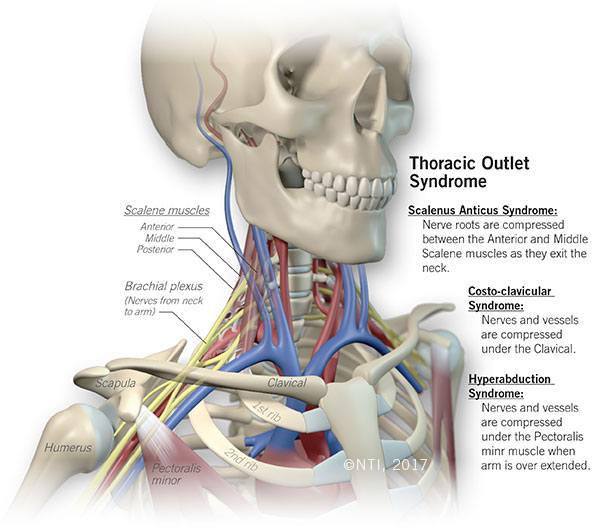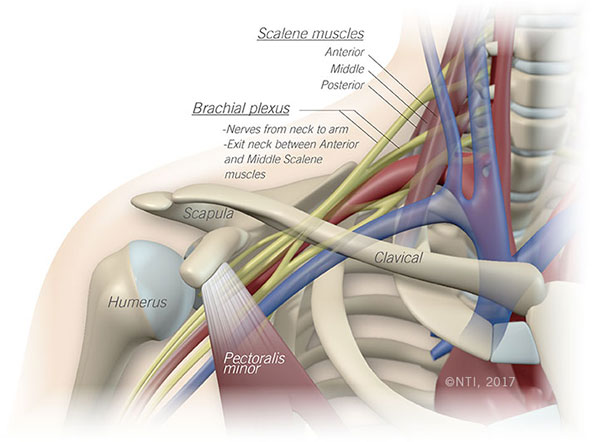
Thoracic Outlet Syndrome
Thoracic Outlet Syndrome
Thoracic Outlet Syndrome (T)OS is caused by the compression or “pinching” of nerves and blood vessels in the space in the lower part of the neck, above the clavicle, across the first rib, and through the upper part of the arm.
The compression of these nerves can be caused by a variety of reasons. Physical trauma (ex. Car accident, fall, etc), repetitive motion injuries secondary to job or athletic activities (weight lifting, pitching, etc) are the most common etiologies. Certain anatomic defects such as extra rib or tumors causing compression can also result in symptoms of TOS.
Individuals with occupations requiring extensive use of the upper extremities have an increased risk of developing TOS. This could vary from construction workers to dental hygienists. Proper posture training, stretching and strengthening the proper muscle groups through physical therapy are important measures that can be taken in order to prevent and treat TOS.
There are three types of TOS.
- Neurogenic: This refers to the compression of the brachial plexus nerves that run through the arm and hand. 85-95% of all of individuals diagnosed with TOS are affected by this type of TOS. Neurogenic TOS is the most difficult to diagnose and treat.
- Venous: This refers to the compression of the axillary and/or subclavian veins which are the main veins that serve arm. These can result in arm swelling and new vein formation (i)f the problem is not addressed promptly on one side of the chest wall compared to the opposite side. One arm can become larger and more swollen than the unaffected side.
- Arterial: This can be similar to venous in some ways. In general symptoms will be relieved with the arm in certain positions. Pain and discomfort will be relieved with the arms in the down position.
Symptoms
It can be difficult to pinpoint the exact cause TOS in each patient. However symptoms may include:
- Neck pain
- Shoulder pain
- Arm pain
- Numbness and tingling of the fingers (p)aresthesia
- Impaired circulation to the extremities, often causing discoloration, or neovascularization.
These symptoms may increase when the arms are extended or lifted above the shoulders. More severe cases experience constant, intense pain causing weakness, while some cases may produce only mild, intermittent occurrences of pain and numbness.
Diagnosis
TOS can be tricky to determine and requires extensive healthcare expertise in order to diagnose properly. It is best to identify TOS early; however this is often difficult due to the rare nature of the syndrome. The diagnostic process may include:
- A physician’s review of the patient’s medical history and symptoms.
- Electrical tests (s)uch as electromyogram and somatosensory, however these may not be conclusive for some patients.
- X-rays to identify pinched areas.
- Thoracic outlet protocol CT angiograms
- Physical examination during which a physician may ask the patient to move their arms in a certain manner to determine when discomfort occurs.
Treatment
Mild and severe cases of TOS are very treatable. At the Norton Thoracic Institute (NTI), we aim to relieve symptoms through a multidisciplinary approach. Physical therapy is a crucial part of the treatment protocol. A majority of patients can be helped by following the proper physical therapy protocols.
Treatment for mild cases of TOS include:
- Stretches and exercises to loosen neck and shoulder tissues that can be done at home.
- Regular visits with a physical therapist.
- Anti-inflammatory medication to relax tension in muscles.
Physical Therapy intervention for mild cases of TOS may include:
- Strategies to decrease your symptoms (e.g. pain)
- Exercises to stretch and strengthen shoulder muscles
- Postural reeducation and activity modification
- Manual therapy techniques
- Therapeutic modalities
- Specialized home exercise and activity program
Treatment for more severe cases of TOS include:
- Surgery may be necessary to open the thoracic outlet. The skilled thoracic surgeons at NTI perform neurolysis or freeing up the nerves. By surgically, decompressing the brachial plexus within the thoracic outlet area and removing a portion of the first rib, pressure is released on the surrounding tissues in order to reduce long term pain. Our goal is early mobilization and therapy to the affected side to encourage rapid healing process.
However, TOS is avoidable if proper precautions are taken. Stretching and regular breaks from strenuous work can not only treat TOS, but prevent the overall development of the syndrome.
Living with Thoracic Outlet Syndrome
It is possible to get rid of TOS completely if proper measures are taken. However when dealing with TOS, NIT suggests:
- Avoiding activities that require arms to be held in a position above the shoulders or head for too long.
- Not sleeping on the stomach with arms behind the head.
- Resting during work to reduce fatigue and tension.
- Regular stretching and therapeutic exercises.
- Obese patients might consider weight reduction.
- Visiting a physical therapist for more personalized care and knowledgeable review.
- Talking to others about your condition—both in person and online. Tell family and friends how you feel, and connect with others with the syndrome to learn how they cope.
Sources Used
- http://tos.wustl.edu/What-is-TOS/Types-of-TOS/Neurogenic-TOS.
- http://www.medicinenet.com/script/main/mobileart.asp?articlekey=494#what_causes_thoracic_outlet_syndrome
- PDF Article from Dr. Hashimi: Mackinnon, S., Patterson, G., & Colbert, S. (n.d.). Supraclavicular Approach to First Rib Resection for Thoracic Outlet Syndrome.
- Dr. Samad Hashimi


Learn About TOS at Norton Thoracic Institute
To learn more about our services, call (602) 406-4000.
